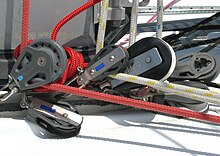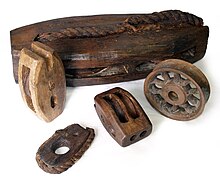Block (shipping)



Block (from Middle High German plock or ploch : large or coherent piece) is a nautical term for a housing in which one or more rotating discs are located. Blocks are used to change the direction of rope pull, or to redirect lines to make them easier to use. Several blocks can lead to a tackle ( Pulley be combined) to be able to exercise greater tensile forces. The housings of modern blocks are made of plastic, aluminum or steel, the discs of polyamide , polyurethane or hard fabric. The traditional material is wood. The discs have ball bearings (to reduce running resistance) or have a slide bearing (allows higher loads and is less maintenance-intensive). Threading a line into a block is called shearing (the line is sheared ). If the catching part , the end of the train, slips out of the block quickly, it is referred to as rushing out (the line rushes out ).
The size and shape of blocks are adapted to the respective use:
- A multi- disk block contains several disks in a housing that rotate about a common or different axes.
- A violin block is a special form of the multi-disc block . There are two disks of different sizes on different axes in one housing. The name is derived from the shape of the casing of such blocks, which is mostly reminiscent of the body of a violin . Violin blocks are often used for tree vang vats on dinghies .
- Ratchet blocks (also: Knarrblocks or Elvström (-knarr) blocks after the inventor Paul Elvstrøm ) are single-disk blocks , the disk of which can only be rotated in one direction (the direction of pull). This makes it easier to tighten and maintain the tension. In order to be able to handle the mainsheet more sensitively when there is little wind, these blocks often have a free-wheel setting in which the blocking is switched off with a lever against the pulling direction. Usually the disc of such blocks is notched or grooved in order to reduce the sheet slipping against the running direction. Ratchet blocks are typically found as the first block on main bulkheads on sailboats, provided the main sail can still be operated without a winch . The function of the ratchet block is the same as that of the ratchet bollard.
- A regatta block is a single-disk block with a particularly large disk diameter and a reduced housing, so that there is low resistance and low weight. The term regatta block refers to a design and not blocks that are suitable for regatta sailing.
- The housing of a hinged block (also: snatch block ) can be opened by flipping it or turning it open after releasing a lock. The block can therefore be placed on a tensioned line afterwards without having to thread it. For this reason, folding blocks are often used by barber haulers .
Curry or V-clamps are often attached to the housing of blocks so that the line running through the block can be occupied directly .
For fastening ( striking ) have blocks via fixed eyelets or lever on the housing:
- A swivel attachment for a shackle is called a swivel .
- An additional eyelet for tying ( attaching ) a leash is called the Hundsfott .
- Different modern types of blocks




